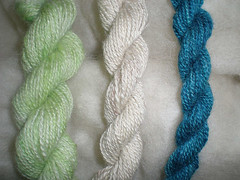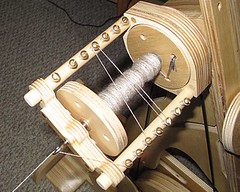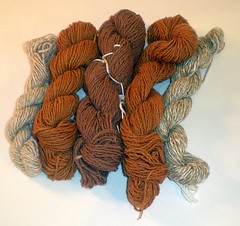 By Amelia
By AmeliaWhether you are exploring spinning lace as a new spinner or an experienced spinner, there are several ways you can have your wheel help you spin finer lace.
On ratios for spinning lace ...
I spin lace at the highest ratio on whichever wheel I'm on, 32:1 on my Majacraft, 35:1 on my Bee. That way I can draft quickly and still get enough twist in for the lace to hang together. The finer you spin, the more twists you need per inch of fiber to make it yarn. So, you could spin lace at 5:1, but it’d be pretty slow. Many, many people spin laceweight at 18:1, which is the middle of the middle on the Bee (mid-ratio lower wheels and middle groove, flyer), or the fastest setting on the high speed whorl for the Majacraft (I get 32:1 using the accelerator head).
The longer you spin lace, the more likely you are to move up to a higher ratio, as your hands learn how to draft more quickly. Or, the faster you learn to treadle … that’s the other option, if your wheel tops out at 18:1 – so yes, you can spin lace on the Pocket Wheel's and Mach 1’s 15:1 top speed, you just treadle faster, the faster you draft.
 The other thing you can set is the draw-in pressure on your scotch tension or double drive; set it so low that the yarn still draws in, but you can pull it off easily while the wheel is spinning. There are a few other things you can do to decrease the draw-in pressure:
The other thing you can set is the draw-in pressure on your scotch tension or double drive; set it so low that the yarn still draws in, but you can pull it off easily while the wheel is spinning. There are a few other things you can do to decrease the draw-in pressure:- Use the lacing shown in the picture if your wheel has hooks or pegs on the same side of the flyer arm (add a second slider on the other arm if you can, for sliders);
- start with a half-full bobbin, half-full of anything -- pipecleaner insulation, already plied yarn, acrylic run onto the bobbin even;
- try setting the draw-in pressure (with the scotch tension) a little low so you have to draw-out to get the draw-on to start. A little pull of yarn off the bobbin will start the bobbin turning, so it will draw-on from then on.
With double drive, you can also decrease the tension a fair bit -- set it down so that the drive band is just barely not slipping on the drive wheel and flyer and bobbin grooves.
Changing out your drive band and scotch tension band, if your wheel has that, for finer material can let you spin a finer yarn too -- it decreases the tension, and thus the pressure of the brake on the wheel.
Fiber will have quite a bit to do with your success at spinning lace – finer fibers (Merino, cashmere) want fine spinning, while coarser ones (Romney, Corriedale) prefer to be spun a bit thicker. Look at the crimp in your wool – the finer the crimp, the finer the fiber likes to be spun. Cashmere & alpaca don’t follow this wool crimp rule – they like fine spinning, generally, being fine fibers. And, they aren't wool.
The finest wool yarn I’ve spun was done by compressing the fiber down – take a 12 inch or so length of commercial top (best prep for this method) and roll it between your hands to compress it. Do this for the entire length. Then, spin from the end. Yes, you’ve matted it, but it will draw out. In fact, it draws out just what it needs to make a very fine yarn :-)
 Fine fibers include cotton, angora, vicuna, guanaco, cashmere, yak, bison, camel down, alpaca, llama, silk, bamboo, the faux-silks (silk latte, seacell, soysilk...), tencel, kid mohair, optim, and a variety of fine wools starting with Merino and including many other lovely breeds such as Shetland, Cormo, and California Variegated Mutant. The non-wools can have other challenges: cotton, cashmere, yak and bison have short staple lengths, benefitting from point of twist drafting or long draw (that would be a long blog post!). The silky fibers (silk, bamboo, faux-silks, suri alpaca, kid mohair, tencel) have smoother surfaces, needing twist in them quickly to hold together rather than draft apart.
Fine fibers include cotton, angora, vicuna, guanaco, cashmere, yak, bison, camel down, alpaca, llama, silk, bamboo, the faux-silks (silk latte, seacell, soysilk...), tencel, kid mohair, optim, and a variety of fine wools starting with Merino and including many other lovely breeds such as Shetland, Cormo, and California Variegated Mutant. The non-wools can have other challenges: cotton, cashmere, yak and bison have short staple lengths, benefitting from point of twist drafting or long draw (that would be a long blog post!). The silky fibers (silk, bamboo, faux-silks, suri alpaca, kid mohair, tencel) have smoother surfaces, needing twist in them quickly to hold together rather than draft apart.
I'll close with some advice I've taken to heart after spinning for many years: how much fiber will you really destroy while learning? When you're working on spinning finer yarn, you might take 4-6 ounces to work out how to spin really fine; once you have the basics under your belt and are spinning a pleasingly thin yarn, you'll find new fibers take even smaller amounts to master -- an ounce, half an ounce, just a few grams at times. Now, if you're going to tackle the finest thread contest, well, for that, you may want to plan on spinning your way through a bit more fiber. Don't be afraid to try spinning finer, you will find that with practice, you can get there.
~~
Top photo: cashmere 2-ply; the dyed skeins spun by the shepherdess, middle skein by me; my one ounce skein of this fiber was 200+ yards. Bobbin photo: Bison/Merino/Cashmere/Bamboo fiber from Louet, a 2-ounce skein spun to 500+ yards; I've spun a skein of seacell to weave with this fiber, project is in-the-works :-). Third photo: naturally colored cotton skeins, all sub-fingering weight 3-plies and one cabled yarn. Fourth photo: closeup of fingering-weight wool/alpaca/bamboo 2-ply spun from a Loop batt. De-lush-ous!
Related posts:
How can I spin a fine yarn?
How can I fit more yarn on my bobbin?
A Yarn Story: Cotton Tales
What makes my handspun yarn bloom?
How thickly should I spin a given breed of wool?
How do you spin angora fiber?
~~
posted 20 April 2009 at http://askthebellwether.blogspot.com/
